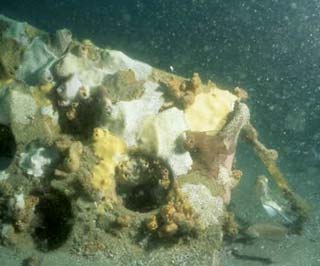Marine - Live Bottom
 Much of South Carolina's sandy sea bed offshore hold little attraction for most fishes and provide no solid substrate for attaching organisms such as sponges and corals. However, scattered rock and coral outcroppings rise above the sand from about 50 feet of water depth out to the edge of the continental shelf.
Much of South Carolina's sandy sea bed offshore hold little attraction for most fishes and provide no solid substrate for attaching organisms such as sponges and corals. However, scattered rock and coral outcroppings rise above the sand from about 50 feet of water depth out to the edge of the continental shelf.
These outcrops, along with ship wrecks and specially constructed artificial reefs collectively make up live bottoms. Entire food webs develop around these live bottoms which provide not just substrate but cover and food for many invertebrates and small fishes of many species, all of which attract larger predators.
Natural live bottoms occur in three zones based on depth. Closest to shore and known as the Blackfish Banks, the first zone extends out to about 100 feet of water. Only three to four feet above the surrounding bottom, these outcrops of limestone and fossilized worm tubes supports sponges, barnacles, algae and soft corals.
Black sea bass, or black fish, is the dominate fish species in the comparatively shallow area. Other prominent fishes on live bottom include various sharks, sheepshead, Atlantic croaker, tripletail, greater amberjack, Atlantic spadefish, great barricuda and king mackerel.
The Snapper Banks occur farther offshore out to 180 feet of water. Here, with relief of up to eight feet above the bottom, rocky outcrops provide attachment for many corals, sponges and sea whips. Red porgies once dominated bottom fishes here, but overfishing has now reduced this species and other bottom fishes, including several species of groupers, as well as red snapper and vermilion snapper.
The Shelf Edge Reef lies at the edge of the continental shelf at depths of 180 feet to more than 600 feet with relief up to 40 feet. On the edge of the shelf the Gulf Stream brings in warmer water and southern organisms, including yellow edge and snowy grouper, hogfish, cobia and scorpion fish along with spiny lobsters and other crustaceans.
Fishes that use live bottoms vary with season especially closer to shore where water temperature changes more radically than in deeper, more staple waters. During cold weather, shallow water species such as bluefish, sheepshead, black drum, spotted seatrout, and some flounder species move to live bottoms, replacing warm water fishes that migrate south during fall and early winter.
